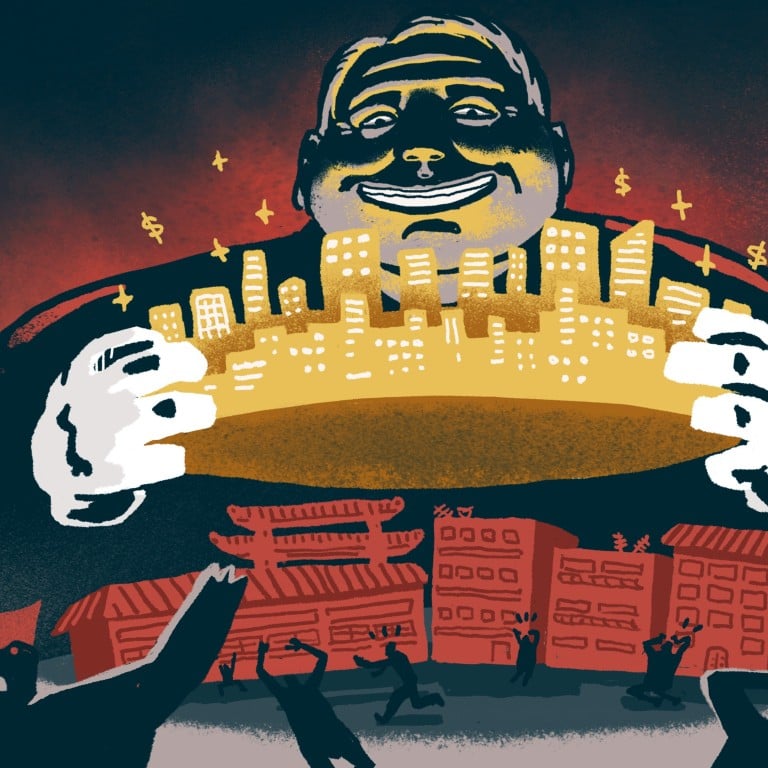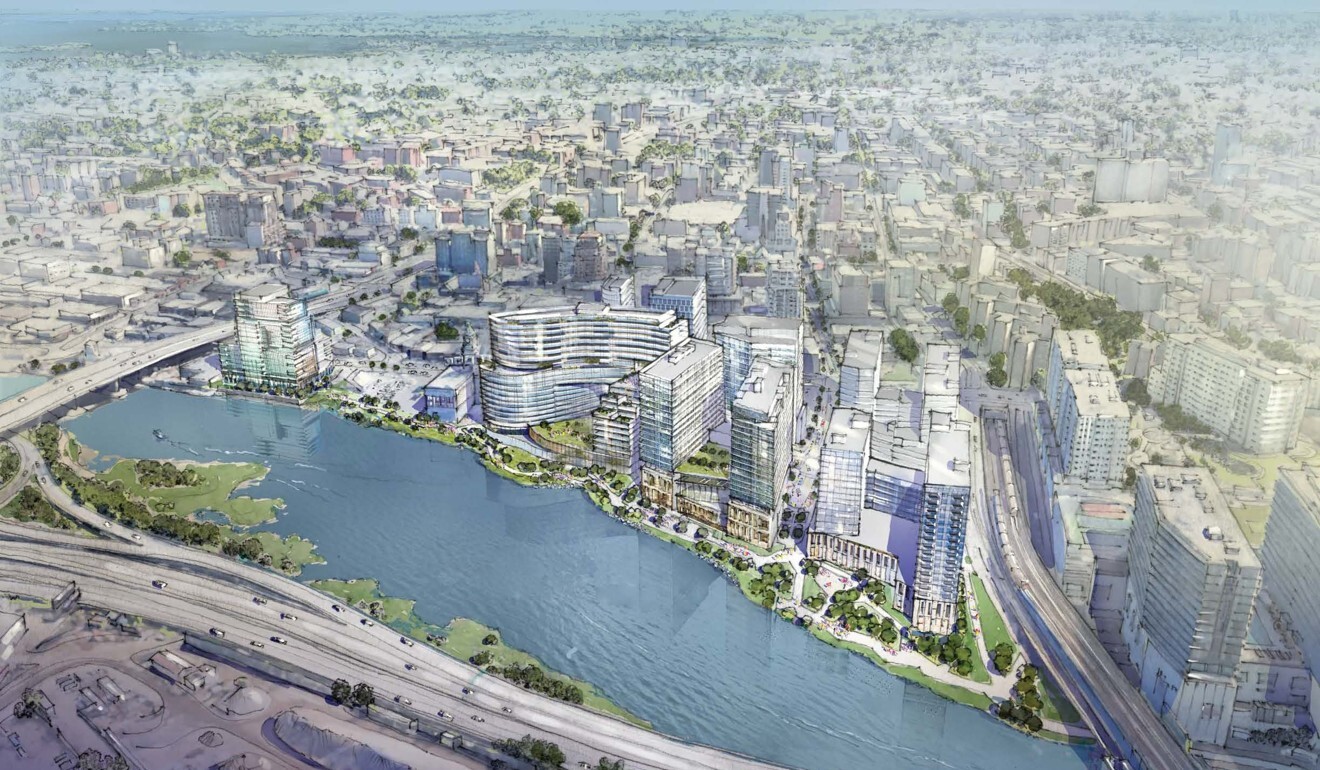
Asian-American New Yorkers battle Chinese developers over a luxury complex in the city’s Flushing neighbourhood
- Gentrification, and the squeeze it puts on residents, comes to a Chinese-American neighbourhood in New York City – but the gentrifiers are themselves Chinese
- ‘We can’t live on condos alone – how a community gets built should be for the people who live and work there to decide,’ one opponent of the project says
Song Deping landed in the United States with little money and big dreams in 2004, settling in New York City’s Flushing neighbourhood.
The Sichuan native lived in a small apartment with strangers, in a bedroom divided in half with a shared toilet and small kitchen; he found jobs in an office, a gym and restaurants before tapping into American’s wellness craze as a licensed masseur. Yet he still struggles to get ahead amid rising prices as Flushing relentlessly heads upscale.
Gentrification in the US has traditionally involved whites displacing minority communities. But a battle in Song’s neighbourhood over the Special Flushing Waterfront District, a luxury development, is raising tensions amid concern that wealthy Chinese-linked developers are now muscling out Chinese-Americans who are barely getting by.
“I really have to tighten my belt to make ends meet,” said Song, who now lives with his wife and infant in a one-bedroom apartment but rents out part of his living room to meet his US$1,800 monthly rent.
“With these developers, land prices in recent years have exploded, affecting everything. I used to buy beef noodles for US$4 a bowl. Now they cost at least US$8 with almost no beef.”

Wealthier newcomers replacing long-time residents is hardly new to the city but Flushing, a traditional gateway for Chinese immigrants in the borough of Queens, stands out.
Over the past two decades, the median price of a condominium more than doubled to US$680,000, according to New York University’s Furman Center, with 40 per cent of Flushing’s renter households considered “severely burdened”, spending more than half their income on rent.
Neighbourhood, labour and small businesses groups have sued the city to block the proposed US$2 billion, 29-acre [11.7-hectare] special district project and slow the inexorable gentrification. The development, which includes 1,725 apartments, 879 hotel rooms and 286,930 square feet of retail across 13 towers, received city council approval in December.
A boon to the area?
Supporters say the project will boost the local economy, generate millions of dollars in tax revenue and create 3,700 jobs. Critics counter that it caters to rich Asians, circumvents environmental regulations, includes few affordable apartments and violates height limits.
The luxury flats are expected to sell for upwards of US$1 million each. Flushing has seen the second-largest number of condos added in the city after Brooklyn’s Williamsburg neighbourhood, according to Nancy Packes Data Services, and two-bedroom units at the adjoining Grand at Skyview Parc development have recently sold for US$1.2 million.
“Enough is enough. We can’t live on condos alone,” said Sarah Ahn, an organiser with the Flushing Workers Centre. “How a community gets built should be for the people who live and work there to decide, rather than who can make the most money.”
New York City, which hosts the largest community of ethnic Chinese outside of Asia, has as many as nine Chinatowns – though residents insist Flushing is the “real” one.
Historically, the neighbourhood has been a melting pot of newly arrived immigrants and well-established residents, with the street life and varied provincial cuisines to rival China. Some see other mainland parallels.
“I feel like the Chinese dynamic has been imported to the US with these rich developers, leaving ordinary people increasing strained to keep up,” Song said.
Videographer Jing Wang has seen this movie before. Her father received 600,000 yuan (US$92,000) when the bulldozers came in 2007 and destroyed the family house in Beijing. “Now one square inch alone is worth 200,000 yuan,” she said. In 2016, she returned and made a short film about the impact of rapid development on her family and China writ large.
Now a well-educated middle-class American living in Flushing, Wang noted a certain irony. “I’m also one of these gentrifiers coming into the neighbourhood, pushing up the rent,” she said, “although it’s not on the scale of these developers.”
Small businesses overlooked
The Greater Flushing Chamber of Commerce, one of the plaintiffs in the lawsuit, said that its membership of modest restaurants, shops and trading companies is an economic engine too often taken for granted.
“In 2008, when the national economy collapsed and New York City was in decline, it was places like Flushing that helped keep New York City afloat,” said John Choe, the chamber’s executive director and a member of the local community board. “On the main streets in Flushing, you now have some of the highest commercial prices in city, more even than Manhattan.”
Choe feels the pressure first-hand. The double barrel of high costs and coronavirus has seen numerous Flushing companies shed workers – the chamber laid off its entire staff, including Choe, who still works there as a volunteer – and go bankrupt, pushing people over the edge.

“I’ve seen people die on our streets that passed away overnight, in cardboard boxes, yet the city continues to push for these luxury developments,” he said. “A year or two ago, the city was ready to offer Amazon more than US$3 billion in tax subsidies in Queens. When is the city going to offer anything similar for small businesses?”
A few feet from the Flushing waterfront, Jim Zhao looked around his auto body shop, affably directing his six-person staff as they pounded panels on Toyota SUVs. Zhao, a Wenzhou native, said he was not told about the massive waterfront project when he moved here in 2019 and hopes the lawsuit stops it in its tracks.
“But these developers have lots of capital and tend to win,” Zhao added. “I spent tons of money to renovate and if we have to move out, we’re screwed.”
TikTok users go crazy over ‘worst apartment ever’ video
Developers with China ties
Local community groups say that the three major developers on the waterfront project – F&T Group, with offices in New York and Shanghai; Young Nian Group, a subsidiary of Shanghai-based Zhonggeng Group; and Queens-based United Construction & Development, which has received financing from the Bank of China – are adept at sidestepping community concerns and pulling political strings.
“We’re talking huge China-based real estate conglomerates involved in this, not community organisations,” said Tarry Hum, chair of the urban studies department at Queens College and an expert in transnational capital and industrial gentrification.
“This luxury development is making it impossible for small businesses to pay commercial rents … F&T is not looking for noodle guys, they’re catering to global elites.”

F&T shows up in the Offshore Leaks database, a 2013 precursor to the 2016 Panama Papers investigation that exposed the murky world of global tax evasion and money laundering. Experts note that there are licit and legitimate uses off offshore entities.
Despite their foreign ties, the three developers promote their local credentials, using WeChat to divide the local community, critics say. The developers also spent more than US$1 million on lobbyists in 2019, the city’s single largest lobbying contract that year, according to the lawsuit.
On its website, F&T touts its long-standing ties with the Flushing community, adding that its goal is to “bring the community together and to celebrate the immigrant roots Flushing was built upon”. The group has built several properties in Queens, as well as the China’s Nanjing World Trade Centre.
How do Chinese women define success? Wealth, not marriage
The developers and their supporters have made adept use of WeChat to widen seams in the Chinese-American community, said Wang, as she walked along the site’s perimeter in the late winter afternoon.
Nearby, a few ducks paddled in the polluted Flushing Creek near a rusting steel fence, old tires and abandoned vehicles as aircraft scream a few hundred feet overhead.
Among their arguments, she noted: we’re all immigrants in this together; we’re just like you in valuing hard work and property ownership; if this project isn’t approved, crime-ridden, low-income housing projects could sprout up instead.
“They really play the fear card, divide the community and appeal to Chinese pride,” she added.

A demographic shift
The showdown has also shined a spotlight on the complex Chinese-American community, its varied interests and changing profile. Historically, immigrants arrived poor and largely uneducated from Hong Kong, Taiwan and the mainland, worked hard and shoehorned their children into the middle class.
But China’s massive wealth and increasingly global elite in recent decades have seen a few migrants slide straight into American society’s top tiers, experts said, while reducing opportunities for struggling immigrants.
“Migration is changing, along with the kind of money that moves with it,” said Andrew Yan, director of The City Programme at Simon Fraser University in Vancouver, British Columbia, an early recipient of this flood of Asian capital.
“That first rung to enter that American dream, we’re knocking those rungs out. Whether it’s a Chinese transnational or a gentrifier, part of that concern is how they become inequality machines.”
Andrew Yang officially running for New York mayor
The developers did not respond to a request for comment. But in September, Young Nian Group president John Liang rejected criticism that the project was an enclave for elites.
“This is not for the super-rich,” he told local reporters, arguing that the 1,700 or so apartments were within reach of young couples early in their career. “This is a place for a starter family.”
TakeRoot Justice, the plaintiffs’ law firm, countered that families with annual income above US$90,960 are eligible for many of the limited number of “affordable” rental units, nearly double Flushing’s median family income. Clearly, the need is there: in 2019, over 84,000 people applied when 231 affordable apartments opened up at the One Flushing complex.
“I have to call their BS. I doubt they even live in Flushing,” Choe said. “When you become a developer, you become a different species … This isn’t being a good steward of this community.”

Taking legal action
Following months of opposition, marches, packed hearings and city council approval, opponents are pinning their hopes on the courts.
The lawsuit argues that the city’s approval must be reversed given traffic congestion, pollution concerns, inadequate affordable housing, zoning sleight of hand and the fact that several of its 13 proposed towers exceed Federal Aviation Administration height restrictions, despite the project’s being on the flight path to LaGuardia Airport.
Plaintiffs said they were less angry with the developers, who are in the business of maximising profits, than with the city for not ensuring the project included a park, community centre and more affordable housing.
Critics add that Flushing West, a similar project proposed for the same site five years ago, was defeated despite the 500 affordable apartments it pledged to build – compared with some 90 for this project – and community amenities.
The Special Flushing Waterfront District, they say, offers far less and has been rammed through.
“As Flushing allows these luxury developments, it hurts small business, making it harder for immigrant entrepreneurs to come to Flushing, start a business and feed and clothe their family,” said Choe. “Flushing has always been a stepping stone to the middle class. But that path is being cut off.”

